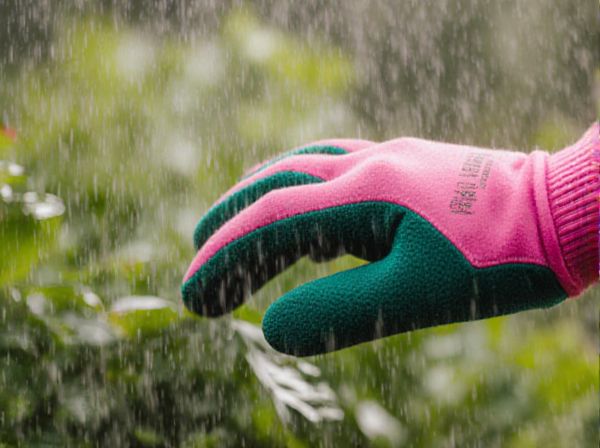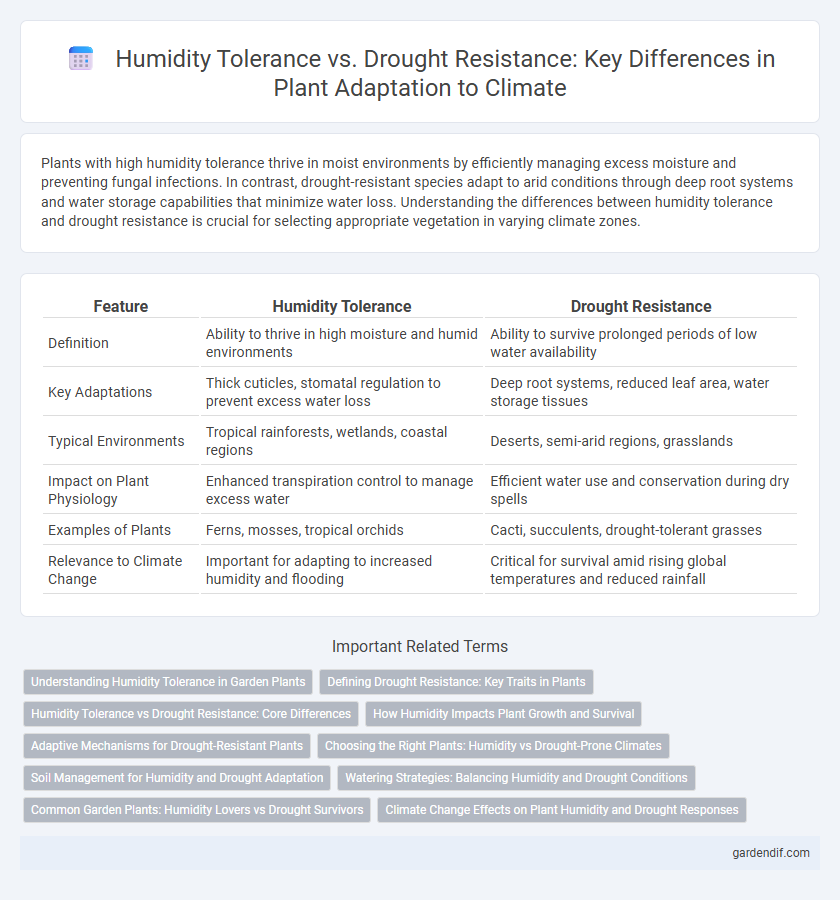
Humidity tolerance vs drought resistance Illustration
Plants with high humidity tolerance thrive in moist environments by efficiently managing excess moisture and preventing fungal infections. In contrast, drought-resistant species adapt to arid conditions through deep root systems and water storage capabilities that minimize water loss. Understanding the differences between humidity tolerance and drought resistance is crucial for selecting appropriate vegetation in varying climate zones.
Table of Comparison
| Feature | Humidity Tolerance | Drought Resistance |
|---|---|---|
| Definition | Ability to thrive in high moisture and humid environments | Ability to survive prolonged periods of low water availability |
| Key Adaptations | Thick cuticles, stomatal regulation to prevent excess water loss | Deep root systems, reduced leaf area, water storage tissues |
| Typical Environments | Tropical rainforests, wetlands, coastal regions | Deserts, semi-arid regions, grasslands |
| Impact on Plant Physiology | Enhanced transpiration control to manage excess water | Efficient water use and conservation during dry spells |
| Examples of Plants | Ferns, mosses, tropical orchids | Cacti, succulents, drought-tolerant grasses |
| Relevance to Climate Change | Important for adapting to increased humidity and flooding | Critical for survival amid rising global temperatures and reduced rainfall |
Understanding Humidity Tolerance in Garden Plants
Humidity tolerance in garden plants refers to their ability to thrive in environments with high moisture levels in the air, which affects transpiration rates and disease susceptibility. Plants with high humidity tolerance typically possess adaptations like waxy leaves, thick cuticles, and stomatal regulation to prevent excess water retention and fungal infections. Understanding these physiological traits helps gardeners select suitable species for humid climates, ensuring optimal growth and resilience against humidity-related stress.
Defining Drought Resistance: Key Traits in Plants
Drought resistance in plants involves physiological and morphological traits such as deep root systems, reduced leaf area, and stomatal regulation to minimize water loss. These adaptations enable plants to maintain growth and productivity under prolonged periods of water scarcity. Unlike humidity tolerance, which allows survival in high moisture conditions, drought resistance specifically targets survival mechanisms during dry, arid environments.
Humidity Tolerance vs Drought Resistance: Core Differences
Humidity tolerance refers to a plant's ability to thrive in environments with high moisture levels, maintaining physiological functions despite constant dampness and potential fungal threats. Drought resistance, on the other hand, is the capacity to survive prolonged periods of water scarcity by reducing water loss and optimizing internal water use. Core differences hinge on humidity tolerance optimizing moisture retention and pathogen defense, while drought resistance emphasizes water conservation and stress endurance mechanisms.
How Humidity Impacts Plant Growth and Survival
Humidity influences plant growth by regulating transpiration rates and stomatal function, directly affecting water retention and nutrient uptake. Plants with high humidity tolerance possess adaptations like thicker cuticles and stomatal regulation to prevent excess water loss, while drought-resistant plants optimize root systems and osmotic adjustments to endure low moisture conditions. Understanding these mechanisms aids in selecting species best suited to variable climates, enhancing agricultural productivity and ecosystem resilience.
Adaptive Mechanisms for Drought-Resistant Plants
Drought-resistant plants exhibit adaptive mechanisms such as deep root systems that access underground water and stomatal regulation to minimize water loss through transpiration. These plants often accumulate osmoprotectants like proline and soluble sugars to maintain cell turgor under low humidity conditions. Enhanced cuticular wax layers and leaf morphology adaptations further reduce water evaporation, ensuring survival in arid environments.
Choosing the Right Plants: Humidity vs Drought-Prone Climates
Selecting plants for climate-specific conditions requires understanding humidity tolerance and drought resistance; species like ferns thrive in high-humidity environments, while succulents excel in drought-prone areas due to their water-storing capabilities. Soil type and local microclimates further influence plant survival, with well-drained sandy soils favoring drought-resistant varieties. Prioritizing native plants adapted to either moisture-rich or arid conditions optimizes garden resilience and water conservation efforts.
Soil Management for Humidity and Drought Adaptation
Effective soil management enhances both humidity tolerance and drought resistance by improving soil structure, increasing organic matter, and optimizing water retention capacity. Techniques such as mulching, cover cropping, and the incorporation of compost boost soil moisture availability during dry periods while preventing waterlogging in humid conditions. These practices promote healthier root systems, enabling plants to adapt to fluctuating moisture levels and maintain resilience in diverse climate scenarios.
Watering Strategies: Balancing Humidity and Drought Conditions
Effective watering strategies require balancing humidity tolerance and drought resistance by adjusting irrigation frequency and volume to match plant needs and environmental conditions. Plants with high humidity tolerance benefit from consistent, moderate watering to avoid fungal issues, while drought-resistant species thrive with infrequent, deep watering promoting root development. Monitoring soil moisture levels and local climate data optimizes water use efficiency, ensuring plant health during fluctuating humidity and drought periods.
Common Garden Plants: Humidity Lovers vs Drought Survivors
Common garden plants exhibit varying humidity tolerance and drought resistance, with humidity lovers thriving in moist, high-humidity environments, such as ferns and calatheas, while drought survivors like succulents and lavender adapt to arid conditions by conserving water. Understanding each plant's transpiration rate and root structure is crucial for optimizing growth in specific climates, thereby reducing irrigation needs and enhancing sustainability. Selecting species based on humidity tolerance and drought resistance promotes resilient garden ecosystems that withstand fluctuating moisture levels.
Climate Change Effects on Plant Humidity and Drought Responses
Climate change intensifies fluctuations in humidity and drought, impacting plant adaptation strategies by altering water availability and atmospheric moisture levels. Plants with high humidity tolerance struggle under prolonged drought conditions due to reduced stomatal regulation efficiency, while drought-resistant species enhance root depth and osmotic adjustment to sustain hydration. Shifts in temperature and precipitation patterns drive evolutionary pressure, influencing species distribution and resilience in diverse ecosystems.
Humidity tolerance vs drought resistance Infographic

 gardendif.com
gardendif.com